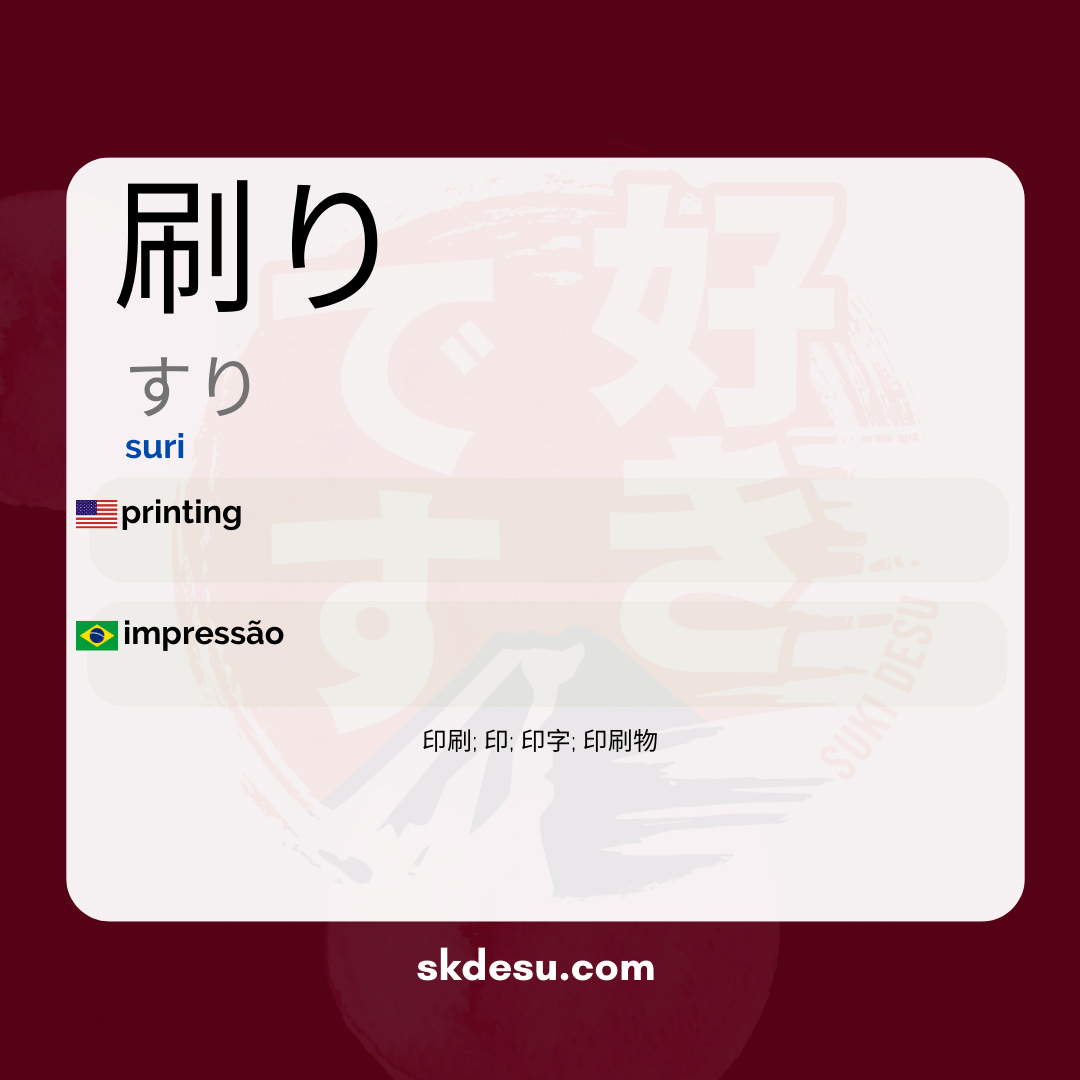Translation and Meaning of: 刷り - suri
The Japanese word 刷り [すり] may seem simple at first glance, but it carries interesting nuances both in its meaning and in its everyday use. If you are studying Japanese or simply curious about the language, understanding terms like this can enrich your vocabulary and even help in practical situations. In this article, we will explore the meaning of 刷り, its origin, how it is used in daily life, and some curiosities that can aid in your memorization.
Additionally, we will see how this word relates to other concepts in the Japanese language and in which contexts it appears most frequently. If you have ever used the Suki Nihongo dictionary to look up Japanese terms, you know how important it is to have clear and precise information. Here, we will ensure that every detail about 刷り is explained in a straightforward and useful manner for your learning.
Meaning and use of 刷り
刷り [すり] is a term that can be translated as "impression" or "print," depending on the context. It is directly related to the act of printing something, whether on paper, fabric, or other surfaces. In Japan, this word is often used in professional settings, such as printing houses and textile industries, but it also appears in everyday situations.
A common example is the use of 刷り in sentences like "この本の刷りはきれいです" (The print of this book is beautiful), where the term refers to the quality of the print. Another possible use is in reference to patterns printed on clothing or objects, showing how the word can be versatile. It is worth noting that, although it is not extremely frequent in informal conversations, understanding it is essential for those dealing with printed or handcrafted materials.
Origin and writing of kanji
The kanji 刷 is composed of the radical 刂 (right side, related to "cut" or "blade") and the component 尸 (which refers to "body" or "form"). This combination suggests the idea of "marking" or "leaving a form," which makes sense considering its current meaning. The etymology of the term is connected to ancient printing techniques, such as woodblock printing, widely used in Japan during historical periods like Edo.
It is interesting to note that, although the kanji itself is not among the most complex, its kun'yomi reading (すり) is less common than the on'yomi (サツ), which appears in words like 印刷 [いんさつ] (printing). This difference can confuse beginners, but understanding the root of the character helps to memorize its uses. One tip is to associate the radical 刂 with something being "cut" or "shaped" on a surface, as occurs in the printing process.
Trivia and memorization tips
An interesting fact about 刷り is that it can also appear in less literal expressions, such as 脳に刷り込む [のうにすりこむ], which means "to engrave something in the mind" or "to memorize deeply." This metaphorical use demonstrates how the idea of "impression" can be applied to abstract concepts, not just physical ones. This type of expression is common in educational or training contexts in Japan.
To memorize the word, one strategy is to think of situations where you see something being "printed" or "stamped." Associating the sound "suri" with the movement of a printing roller, for example, can help solidify the term. Another tip is to practice with simple sentences, like "この模様の刷りは独特です" (The print of this pattern is unique), to get used to its natural usage. Over time, 刷り will become more familiar in your Japanese vocabulary.
Vocabulary
Expand your vocabulary with related words:
Synonyms and similar words
- 印刷 (Insatsu) - Impression, usually referring to the process of printing text or images.
- 印 (In) - Mark, seal, or imprint; it can refer to the symbol or design that represents something.
- 印字 (Inji) - Printing (of text); specifically refers to the printing of characters or numbers.
- 印刷物 (Insatsubutsu) - Printed material; refers to any print material that has been produced, such as books, brochures, etc.
Related words
Romaji: suri
Kana: すり
Type: noun
L: jlpt-n1
Translation / Meaning: Print
Meaning in English: printing
Definition: Print characters or patterns on paper, etc.
Quick Access
- Vocabulary
- Writing
- Sentences
How to Write in Japanese - (刷り) suri
See below a step-by-step guide on how to write the word by hand in Japanese. (刷り) suri:
Example Sentences - (刷り) suri
See below some example sentences:
Watashi wa hon o surimasu
I print books.
I print a book.
- 私 (watashi) - personal pronoun that means "I"
- は (wa) - topic particle that indicates the subject of the sentence, in this case "I"
- 本 (hon) - noun meaning "book"
- を (wo) - direct object particle that indicates the object of the action, in this case "book"
- 刷ります (suraimasu) - verb that means "to print"
Other Words of this Type: noun
See other words from our dictionary that are also: noun

